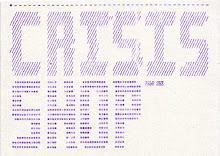
“Perpetual crisis” led to the notion of “No time for games” or the beginning of the “Game Over” series… an interest in the subversion or inversion of redundant sports equipment that could serve a new purpose.
Looked specifically at the structure of Tennis Balls.
How can the tennis ball and its constituent parts be reinvested to create new typologies out of the existing materials?
Having cut a tennis ball in half I was keen to use its waterproof and symmetrical properties in the form of a hat.
This led to interest in the qualities of the fluorescent tennis ball felt itself.
How could I intervene earlier in the production of a tennis ball in order to make better use of its constituent parts?
I looked again at the history of felt which dates back to 6,500 BC.
It is fascinating the way a material can retain a relevance and use from 6,500 BC to the present. How can I make reference to this span of history in the modern felt interpretations that I will make?
"Felt is the oldest form of fabric known to mankind. It predates weaving and knitting, although there is archaeological evidence from the British Museum that the first known thread was made by winding vegetable fibers on the thigh. In Turkey, the remains of felt have been found dating back at least to 6,500 BC."
"Felt is made by a process called wet felting, where the natural wool fiber is stimulated by friction and lubricated by moisture (usually soapy water), and the fibers move at a 90 degree angle towards the friction source and then away again, in effect making little "tacking" stitches. Only 5% of the fibers are active at any one moment, but the process is continual, and so different 'sets' of fibers become activated and then deactivated in the continual process."
This "wet" process utilizes the inherent nature of wool and other animal hairs, because the hairs have scales on them which are directional. The hairs also have kinks in them, and this combination of scales (like the structure of a pine cone) is what reacts to the stimulation of friction and causes the phenomenon of felting. It tends to work well only with woolen fibers as their scales, when aggravated, bond together to form a cloth.



No comments:
Post a Comment